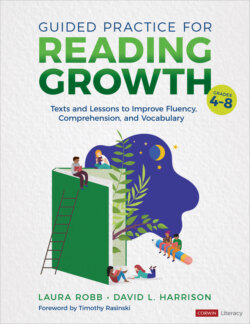Читать книгу Guided Practice for Reading Growth, Grades 4-8 - Laura Robb - Страница 28
На сайте Литреса книга снята с продажи.
Developing Readers Need to Talk About Texts
ОглавлениеStudent partners discuss pictures and text to deepen comprehension.
Many developing readers have not had opportunities to read and discuss books with a partner or in a small group. Even if they’ve listened to teachers read books aloud, there’s no guarantee that they were listening and remembering. An ideal time to model how to talk about reading is during daily read-alouds and small group instruction. For example, you can talk about literary elements (see Appendix C), your feelings, and the text structures of informational books such as compare/contrast, cause/effect, and problem solution (Allington & Johnston, 2002; Garas-York & Almasi, 2017; Robb, 2017).
Using the picture book Free As A Bird: The Story of Malala by Lina Maslo as a text, I’ve included examples in italics of the kinds of text-focused talk I model for students. These are examples you can adapt and refine as you plan think-alouds based on a read-aloud or when discussing a common book with small groups:
The protagonist and problems: I know Malala will have problems growing up in Pakistan when people say after her birth, “What bad luck.” This makes me think that adults see girls as second rate, and it’s better to have boy babies.
Feelings the book raised: I felt sad when Malala realizes women didn’t have the same rights as men. She was supposed to marry early and have children. If she had dreams of what she wanted to be, she most likely couldn’t achieve them.
Decisions made: Malala’s father encouraged her to be free and follow her dreams. She attended school and won public speaking contests. The Taliban threatened her life when Malala decided to talk about education for girls. She continued to attend school even though it was dangerous.
Antagonists’ role: The Taliban threats made Malala want to go to school and keep talking about her belief in education for girls. Their threats and the thought of not being able to go to schools gave her strength to speak out.
Outcomes: The enemy shot Malala, but she recovered in England. Once Malala was well, she became an activist, speaking out for equality and education for girls around the world.
Changes in the protagonist: Malala did not accept the traditional role for Pashtun girls. Instead, she spoke out for girls in her country and continues to speak out all over the world. She developed boundless courage and the belief that education and learning was a right for boys and girls.
Settings: The book starts in Pakistan to show a girl’s position in Pashtun society and what Malala fought against. It also shows her father’s and mother’s support for Malala to achieve her dream of being educated.
Cause/Effect: Cause: The government and enemy fired guns at each other. Effect: Malala and her brothers hid in their parents’ bedroom. Secretly, Malala continues to go to school.
Encourage students to notice what your response showed to ensure they understand your thinking. Most likely, you’ll be met with silence the first few times you do this. That’s okay, as talking about a text is new territory for these students. Continue to think-aloud, explain your response, and eventually, students will join the noticing conversations.
Time to Reflect
Reserve time to mull over what you’ve read in this chapter. Discuss the questions that follow with yourself or a colleague who is also reading this book.
How do guided practice lessons improve developing readers?
Why is it important for students to do the lion’s share of the work?
Why are kid-watching and taking observational notes important to student’s progress?
